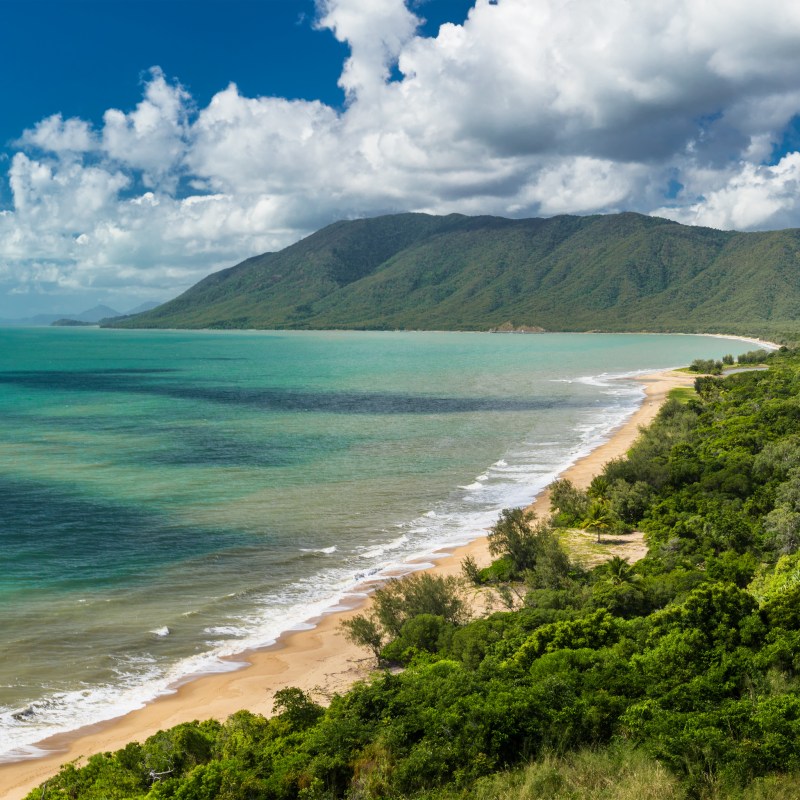
Australia is a country with stunning land- and seascapes, and it is dedicated to protecting its unique habitats and the flora and fauna that live in them. Often, the best way to protect a region of particular natural beauty or interest is by declaring it a national park, to be governed by strict rules and watched over by regional or national guides, and Australia has protected many beautiful places.
Videos by TravelAwaits
Choosing which Australian national park to visit is not easy — not as easy as in some countries, anyway. Australia has hundreds of national parks to pick from, with Queensland alone having 237 of them. Compare that to, for example, the U.S., with 62; China, with 225; and Brazil, with 69, and you know you are in trouble when having to select your favorites.
To help you decide where to go, I recommend some of my favorite national parks along the Great Barrier Reef-facing coast of Queensland, following some strict rules: I excluded all islands (you can read up on the nine best Islands of the Great Barrier Reef if that’s the experience you’re after) and included a wide variety of points of interest and reasons for picking a particular park. They are all within a couple hours’ drive from the main road, the A1 — barring one exception, but that one is truly special.

1. Capricorn Coast National Park
Stretching along the coast between Yeppoon and Emu Park east of Rockhampton, Capricorn Coast National Park is known for its mangroves, tussock grassland, and eucalyptus forest, all set along a rocky coast and idyllic bays that offer stunning views across Keppel Bay toward the Keppel Islands. Great picnic spots line the coast, and, as the name Emu Park suggests, you can often spot the large flightless birds walking through the shrubland.
One must-do is the Bluff Point Circuit walk, which is around one and a half miles long and takes an hour to complete — longer if you take a picnic to eat at Bluff Point while enjoying the fabulous views. There is a steep climb to Turtle Lookout, but it is achievable if you take your time. The good thing is, you can stop along the way, catch your breath, and (at least pretend to) enjoy the views. Once at the top, you might just be able to spot turtles down below, making it very much worth it.
Pro Tip: I got “swooped” by a large Australian magpie in Yeppoon, drawing blood on my head. Breeding season is anywhere between July and December, and the parents are rather tetchy when it comes to protecting their eggs and chicks from innocent passersby. Wear a hat and be on the lookout while in the region.

2. Eungella National Park
One and a quarter hour’s drive inland from Mackay, Eungella National Park offers gurgling streams, forest walks, great views from the hilltops, rainforest gullies, and Broken River, which is famous for its platypuses. This is one of my personal favorite national parks in Queensland, simply due to the variety of landscapes and its magical forest. And seeing platypuses here is one of my favorite fantastic animal experiences along the Great Barrier Reef.
The park boasts Australia’s longest and oldest stretch of subtropical rainforest and takes its name from an Aboriginal word meaning Land of the Clouds. There are more than 12 miles of marked bushwalking tracks, plus the Mackay Highlands Great Walk, which is a 30+ mile trail that takes three to five days to complete. Whether you take the shorter tracks or walk for days, you can enjoy looking out for some 200 species of birds, the famous platypus, rare frogs, and other critters along the way.
Pro Tip: Spend the night in Broken River to really enjoy your time here, and to have a chance to get up early enough to see a platypus in action.

3. Conway National Park
This park stretches along the coast by the Whitsunday Islands, offering everything from pines to rainforest, secluded beaches to stunning hilltop views across to the islands. You should be able to spot quite a few as you go.
If you are a hiking enthusiast, the Conway Circuit is a 17-mile trail through Conway State Forest starting at Brandy Creek and finishing in Airlie Beach. For shorter options, either start this trail from Kara Crescent in Airlie Beach, or follow the Kingfisher Circuit or Wompoo Walk, all of which are parts of the longer trek.
Pro Tip: Along the walk, look out for the absolutely stunning Ulysses butterfly, which is bright blue and has a wingspan of over four inches.

4. Wooroonooran National Park
This national park is great for chasing waterfalls. Large and small, there are at least eight to be found. You can easily access the park from the cute town of Babinda some 40 miles south of Cairns. The name Babinda is derived from the local Wanyurr Yidinji people’s language. Bunna binda means “water passing over your shoulder,” which is said to refer to the lovely smooth boulders that are found in the streams here. Binda, specifically, means “waterfall.” Start your outing at the Boulders, signposted from Babinda, and you can follow various walks from the parking lot, finding waterfalls as you go. Just come prepared, as Babinda is one of the wettest places in Australia, receiving 14 feet of rainfall per year, which explains the lush green all around and the abundance of waterfalls in the area.
Pro Tip: Only a 30-minute drive from Babinda, due south, you will find Paronella Park, an enchanting park and castle built by a Spanish immigrant for his love in the 1930s.

5. Barron Gorge National Park
While we are on waterfalls, this one is superb: Barron Gorge sees the Barron River fall 820 feet to the coastal lowlands, making quite a spectacle. The national park reaches from the Atherton Tableland, across a mountain range with the picturesque artsy settlement of Kuranda, and down to the coast by Cairns. It offers everything from mountain hikes to afternoon teas in the tablelands, lakes flocked by birds to rainforest and river cruises. One of the best and easiest ways to enjoy an overview of the park is to take the Skyrail, a cable car, from the coastal side, stop off for forest walks led by indigenous rangers as you reach a midway transit stop, spend a few hours in Kuranda, and then take the vintage train back through the mountains, enjoying stops at the Barron Gorge and trundling along the awe-inspiring narrow track snuggled into the mountainside.
Pro Tip: Book a round trip on the cable car and train and make sure you upgrade yourself to Gold Class, as you get a glass of wine and nibbles to be enjoyed as you pass the scene unfolding outside your window seat.

6. Undara Volcanic National Park
This national park is the exception mentioned in the introduction. It is exceptional not only because it is Australia’s only volcanic national park, but also because it is a 3.5-hour drive from the coast. But, in my defense, it is not only a scenic drive through the Atherton Tableland and then along a long stretch of road into the Australian Outback where you feel you are the only person on this planet, but it is also really worth the detour. Undara offers you not only walks along long-extinct volcano craters but also tours through lava tubes that were formed when the lava flow cooled and hardened on the outside, but the inside was still hot enough to move along, leaving an empty tube. This is one of the longest lava tube fields in the world, and the sights are otherworldly. Add to that kangaroos, bats, birds, and snakes, and you will enjoy a true Australian Outback experience with a difference.
Pro Tip: Stay the night and enjoy two or three guided walks to get the most out of this unique landscape. And you can stay in upcycled train cars, which is fun.

7. Daintree National Park
This is one of the most magical and oldest places on this planet, and one of my absolute favorites. This park, owned traditionally by the Eastern Kuku Yalanji Aboriginal people, consists of two parts separated by the Daintree River, and quite different from one another: Mossman Gorge and Cape Tribulation. Mossman Gorge is famous for its (yes, another) waterfall, and its gorge walks led by indigenous guides, which include the telling of stories about their people — a must-do, if only to learn about the ancient history of the Aboriginal people and about this land of theirs.
Cross the Daintree River, and you reach the oldest rainforest in the world, 180 million years older than the Amazon. This part of the park stretches all the way up to Cape Tribulation, some 70 miles north of Cairns, which has been listed as a Wet Tropics World Heritage Area since 1988.
This feels like, and quite literally is, one of the most remote regions on this overcrowded planet, and a place where humans are a mere afterthought amongst the abundance of flora and fauna.
Pro Tip: This is a truly unique spot, and if you made it this far, do spend some time to really enjoy the seclusion of the region. There are a few eco-lodges and campsites where you can stay and not only be pampered but also learn about the forest and its secrets. For more inspiration, read up on seven things you can only experience in this Australian rainforest.
